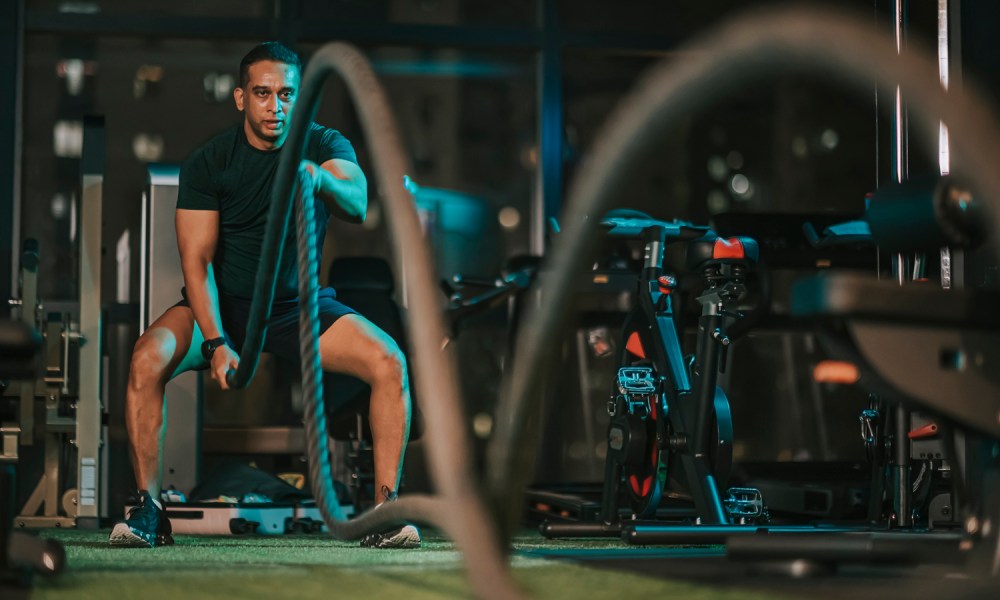With so many different kinds of equipment available to use in the gym, it can be an exciting yet overwhelming task to figure out what to use during your workouts. As a trainer, I consistently tailor my clients’ workouts so they use equipment that helps them both build muscle and lose weight.
One consistent favorite among my clients is the battle ropes. Great for building endurance and strengthening the entire body, we recommend that you give the ropes a try. Keep reading to learn how to use battle ropes, their many benefits, and more!
What are battle ropes?

John Brookfield sought a way to improve his strength and agility in 2006, so he developed battle ropes as a solution. Battle ropes are a versatile piece of workout equipment that helps condition your body by combining strength training and cardio.
Many people use them for high-intensity interval training in the gym or at home to build strength, burn calories, and achieve other fitness-related goals.
What muscles do battle ropes target?

Battle ropes are great, as they target numerous upper-body muscles. These include the following:
- Deltoids: The front, lateral, and rear deltoid muscles surround your shoulder joints. These muscles allow movements like arm abduction and flexion. They also keep your shoulders stable. Battle ropes strengthen and stabilize the deltoid muscles by placing constant pressure on them through their movement.
- Obliques: The obliques are the muscles located on either side of your abdomens. They consist of the external and internal obliques. The former extends from the side of your abs to the middle, allowing you to move your torso sideways. The latter are atop the external obliques, running from your sides to the middle. They work to support trunk movement. The twisting and contractions involved in battle rope exercises strengthen and tone your obliques.
- Trapezius: Your traps are large muscles that span your upper back. They help you move your head, shoulders, and upper back, as well as maintain correct posture. Battle ropes typically involve forceful movements that target and strengthen the upper body, and the traps benefit from such movements.
- Latissimus dorsi: Also referred to as the lats, the latissimus dorsi are large triangular muscles that cover your middle and lower back. They keep your back in place while extending other parts of your body. Battle rope variations such as seated waves help strengthen your lats. The exercise involves moving the ropes vertically in a wave-like manner while sitting to provide a different challenge.
What are the benefits of using battle ropes?

Burns calories
As mentioned above, battle ropes combine cardio and strength training. While you can adopt them for strictly high-intensity exercises, they are also endurance-based as they test how long you can keep swinging the ropes. That way, you burn more calories in a shorter period of time than when you do strength training or cardio separately.
Low-impact option
Battle ropes are ideal for people who want to maximize their workouts without putting too much pressure on their joints. Your arms do more of the work, as your feet are planted while using the ropes, so you won’t be moving your lower body much. A study suggests that “battle ropes may be a low-cost, accessible option to improve cardiovascular endurance for individuals who cannot stand or move their lower extremities in a rhythmic manner to conduct aerobic exercise.”
Offers a full-body workout
While battle ropes primarily target the upper body muscles, including the traps and delts, its variations can impact other areas of your body. For example, you could maintain a deep squat while swinging the ropes to challenge your quads and glutes. How you swing the ropes may change the emphasis on your upper body as well.
How to use battle ropes

Instructions:
- Stand upright and hold one rope in each hand.
- Bend your knees and adopt a partial squat posture.
- Lean forward and keep your spine neutral.
- Whip the first rope to form an alternating wave pattern that reaches the end of the rope.
- Repeat the same wave pattern with the second rope.
- Maintain the movement of the ropes and increase the intensity to engage different parts of your body.
Recommended sets and reps: Do 3 to 5 sets of 15 reps. Ensure you rest for 60 to 90 seconds between the sets to recover.
How often should you use battle ropes for results?

This varies since it depends on your fitness goals. However, using battle ropes two to three times per week is a step in the right direction. Also, try to be consistent and use other variations of battle ropes for an optimum experience.
Frequently asked questions

Are battle ropes really effective?
Yes, battle ropes are effective. They are a great way to build abdominal and upper body strength, as well as endurance, with a single piece of equipment.
How long should you do the battle rope for?
There is no set rule for how long battle rope workouts should last. However, this will usually depend on your fitness level. For example, 10 minutes of battle rope is recommended for beginners. Other fitness levels can increase the time based on their endurance.
What happens to your body when you do battle ropes every day?
Doing battle ropes daily can boost your physical health by making you more stable and strong and improving your endurance. It can also help you reach your fitness goals, whether they are to build muscle or lose weight.




